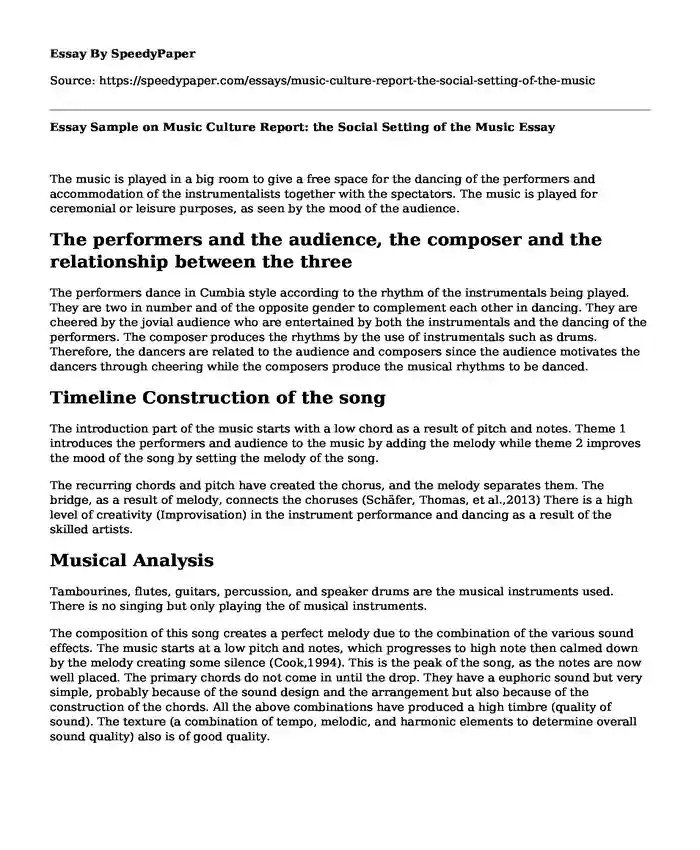
| Type of paper: | Essay |
| Categories: | Music Culture Inspiration |
| Pages: | 3 |
| Wordcount: | 724 words |
The music is played in a big room to give a free space for the dancing of the performers and accommodation of the instrumentalists together with the spectators. The music is played for ceremonial or leisure purposes, as seen by the mood of the audience.
The performers and the audience, the composer and the relationship between the three
The performers dance in Cumbia style according to the rhythm of the instrumentals being played. They are two in number and of the opposite gender to complement each other in dancing. They are cheered by the jovial audience who are entertained by both the instrumentals and the dancing of the performers. The composer produces the rhythms by the use of instrumentals such as drums. Therefore, the dancers are related to the audience and composers since the audience motivates the dancers through cheering while the composers produce the musical rhythms to be danced.
Timeline Construction of the song
The introduction part of the music starts with a low chord as a result of pitch and notes. Theme 1 introduces the performers and audience to the music by adding the melody while theme 2 improves the mood of the song by setting the melody of the song.
The recurring chords and pitch have created the chorus, and the melody separates them. The bridge, as a result of melody, connects the choruses (Schäfer, Thomas, et al.,2013) There is a high level of creativity (Improvisation) in the instrument performance and dancing as a result of the skilled artists.
Musical Analysis
Tambourines, flutes, guitars, percussion, and speaker drums are the musical instruments used. There is no singing but only playing the of musical instruments.
The composition of this song creates a perfect melody due to the combination of the various sound effects. The music starts at a low pitch and notes, which progresses to high note then calmed down by the melody creating some silence (Cook,1994). This is the peak of the song, as the notes are now well placed. The primary chords do not come in until the drop. They have a euphoric sound but very simple, probably because of the sound design and the arrangement but also because of the construction of the chords. All the above combinations have produced a high timbre (quality of sound). The texture (a combination of tempo, melodic, and harmonic elements to determine overall sound quality) also is of good quality.
Key Non-Musical/Extra-Musical Elements of the Performance and Culture
Cumbia dancing. This type of dancing is an identity to the Columbia culture, and it entertains the audience. Therefore, it has an aesthetic and symbolic value to the music being played. The dressing of the dancers symbolizes Colombian culture.
Music history
Beginning as a romantic move among West African slaves in Colombia's Caribbean waterfront area and Panama in the mid-nineteenth century, the Cumbia was initially performed utilizing just drums and claves (L'hoeste, Hector Fernandez, 2013). In the long run, the music joined impacts from the indigenous Kogui and Kuna tribes in addition to flutes and percussion, the Spanish ( guitars of the Europeans), and even German settlers who got the accordion to Barranquilla in the nineteenth century.
By the mid-twentieth century, which was known as the Golden Age, Colombian specialists, for example, Pablo Galán and Lucho Bermúdez, had created a refined type of Cumbia, which helped the music spread to the nations of Chile, Argentina, Peru, Brazil, and past.
How Cumbia music has evolved
Nowadays, customary Cumbia is often mixed with reggae dancehall, hip-jump, and electronic melodic impacts to make a progressively present-day, available sound(D’Amico, Leonardo, 2013). And while the popular music of Shakira and Rock en Espanol delivered by the famous Juanes might be all the more generally known in the United States, it is Cumbia that is the encapsulation of Colombia's rich, unmistakable social combination.
Works Cited
Wingood, Gina M., et al. "A prospective study of exposure to rap music videos and African American female adolescents’ health." American journal of public health 93.3 (2003): 437-439.
Schäfer, Thomas, et al. "The psychological functions of music listening." Frontiers in Psychology 4 (2013): 511.
Cook, Nicholas. A guide to musical analysis. Oxford University Press, USA, 1994.
D’Amico, Leonardo. "Cumbia Music in Colombia: Origins, Transformations, and Evolution of a Coastal Music Genre." Cumbia (2013): 29-48.
L’HOESTE, HECTOR FERNANDEZ. "Toward a Critique of the History of Cumbia." Cumbia!: Scenes of a Migrant Latin American Music Genre (2013): 248.
Cite this page
Essay Sample on Music Culture Report: the Social Setting of the Music. (2023, Aug 10). Retrieved from https://speedypaper.net/essays/music-culture-report-the-social-setting-of-the-music
Request Removal
If you are the original author of this essay and no longer wish to have it published on the SpeedyPaper website, please click below to request its removal:
- Essay Example: King Oedipus Play Rhetorical Analysis
- Cultural Competence in Organizations - Free Essay for You
- Free Essay: Effects of Transformational Leadership on Nursing
- Essay Sample on Speaker Summary - Alexandra Patsavas
- Essay Example on Observing: Describe a Picture or a Photograph
- Corporate Social Responsibility and Organizational Psychology - Free Paper Sample
- American Ideology and Social Life Affects Work - Free Essay
Popular categories




